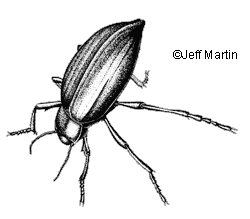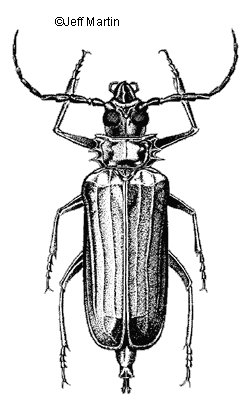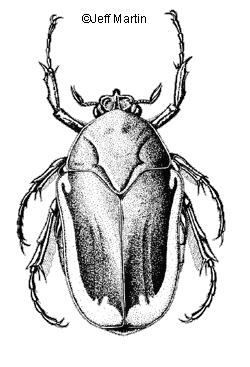Beetles
Beetles comprise the largest group of insects on Earth, representing one-quarter of all living organisms and one-third of all animals, with nearly 350,000 species grouped into more than 150 families. Beetles owe their success, in part, to an external skeleton, or exoskeleton, which functions as both skin and skeleton. The outer surface of the exoskeleton may be covered with spines, or hair-like structures, or coated with waxy secretions. These adornments may function as sensory transmitters of environmental information to the nervous system, or serve as additional protection from predators, abrasion, and desiccation.
 |
The beetle head provides the housing for such delicate and primary sensory structures as the eyes and antennae. The antennae are equipped with sophisticated receptors used to detect food, locate egg-laying sites and assess temperature and humidity. Male beetles may have elaborate antennal structures to increase their powers of smell—especially those species that use specific scents, or pheromones, to locate mates. The mandibles are usually conspicuous and are variously modified to cut, grind, and strain foodstuffs, occasionally serving as a means of defense. The thorax is the powerhouse of the beetle body, enclosing an internal battery of muscles used to drive the legs and wings. The forewings of beetles are usually thick and leathery, protecting the delicate flight wings and the circulatory, respiratory, digestive, excretory, and reproductive systems housed within the abdomen.
| Order: Coleoptera |
| Families: Scarabaeidae, Tenebrionidae, Cerambycidae |
| Sonoran Desert species: |
|
fig beetle (Cotinis mutabilis), pinacate beetle (Eleodes spp.), palo verde root borer (Derobrachus geminatus), cactus longhorn beetle (Moneilema gigas) |
| Spanish names: |
|
escarabajo, mayate, coleóptero, cochinilla (cochineal), mayate verde (fig beetle), torito, longicornio (cactus longhorn beetle) |
Life History
The stages of complete metamorphosis—egg, larva, pupa, and adult—serve to adapt each beetle species to a dynamic suite of seasonal and ecological conditions. Most beetles have fairly regular life cycles, with one or more generations per year. Beetles either produce eggs singly or by the hundreds, scattering them about haphazardly, or carefully depositing each one on or near suitable larval foodstuffs. Upon hatching, the larva begins its life with a single purpose: to eat. Beetle larvae may scavenge carrion, consume animal excrement, attack roots, mine through leaves or chew their way through wood. The pupa serves as the vessel in which dramatic transformations take place, reconstructing the tissues of a non-reproductive eating machine into a precision breeding instrument that may or may not require food.
Ecology
The thickened wing covers of small, compact beetles protect them from abrasion and desiccation as they move about through soil, detritus and decomposing plant materials, allowing them to hide, feed, and reproduce among the myriad of niches found in the environment. The cavity beneath the forewings serves as a site for the storage of oxygen in aquatic species, while insulating desert-dwelling species from the heat and minimizing water loss through respiration. In fact, studies with the pinacate beetle, Eleodes armata, have shown that the cavities beneath their forewings may be warmer than the ambient temperature, indicating that they may function as both convective cooling and heat buffering systems.
Resource Economists
Receiving little rain and exposed to often wildly oscillating fluctuations in temperature, deserts are home to a rich and dominant beetle fauna whose basic physical features are remarkably similar throughout the world. This parallel evolution is a result of the fact that beetles living in deserts have all adapted both behaviorally and morphologically to cope with the lack of water.
 |
Many species of the beetle family Tenebrionidae are wonderfully adapted to desert life. These wingless and usually black species escape extreme temperatures by remaining buried in the sand during the heat of the day, where temperatures may be significantly lower. The pinacate bettles of the genus Eleodes are also called clown beetles because of their defensive stance—they stand on their heads. This action precedes the release of a foul, oily fluid from repugnatorial glands located at the tip of the abdomen, a defense that repels most predators. However, the grasshopper mouse is not deterred by the beetle’s odiferous offerings—it simply grabs the beetle with its paws, forcing the tip of the abdomen into the sand, and eagerly begins to consume the tastier head and thorax, stopping just short of the ill-tasting defensive glands. A relative of the pinacate beetle, the ghost beetle (Asbolus verrucosus), however, is not endowed with such a chemical defense system. Rather, when disturbed, this beetle simply collapses to one side and pretends to be dead, an act that may last from several minutes to several hours. The thick, roughened exoskeleton of the ghost beetle, reminiscent of the impenetrable metallic exterior of battle ships, serves to conserve moisture. Further protecting this beetle from desiccation is a bluish-gray waxy secretion exuded by glands whose ducts are located at the tip of knob-like projections on the forewings. The lighter color produced by the wax also reflects ultraviolet light, helping to keep the body cool. The larvae of both Asbolus and Eleodes resemble mealworms and are sometimes encountered burrowing through the sand where they feed on plant detritus.
Beetles employ a broad array of tactics to fool their enemies, using mimicry, camouflage, and warning coloration. The cactus longhorn beetle, Moneilema gigas, resembles the foul smelling and unrelated Eleodes, both in appearance and behavior. Tests have shown that species of Moneilema behave in a way similar to Eleodes when faced with predators such as lizards, wood rats, and skunks. Although these cactus longhorn beetles can be found on the ground wandering about, their preferred spiny host, the cholla, also affords them a considerable degree of protection. Adult Moneilema feed on the softer, more succulent portions of the cactus. The female lays her eggs at the base of the cactus inside an earthen case. Upon hatching, the larvae bore into the roots and stems of the cactus to feed. Their boring activities above ground are conspicuous, as they expel tar-like excrement and fluid from the wounds created by their feeding activities.
Recyclers
 |
Beetles are a major component of the “F.B.I.”—fungi, bacteria, and insects— the primary agents of decomposition. Without them the planet would soon be covered with dead animals and plants. For example, a dead tree branch presents a number of feeding niches for long horned wood-boring beetles, in terms differently-sized stems and the different layers of tissue, from the bark inward. Furthermore, as a dead branch ages, there is a succession of different beetle species that work in concert to complete the recycling process. The adult palo verde root borer, Derobrachus geminatus, grows to more than 3 inches (76 mm) in length and may commonly be encountered during the early evening hours of summer, when it is often attracted to street lights and well-lit storefronts. Females lay their eggs just below the surface of the ground on the roots of a variety of native and non-native trees. The larvae, which may reach 5 inches (130 mm) in length, bore through the live roots of the host tree, consuming woody tissues. Microorganisms, such as bacteria, yeasts, and fungi located in the intestinal tract of these and other wood- boring beetles assist in the digestion of cellulose, whether the tissue is living or dead. These microorganisms are passed to the larvae from their mothers as they pass through a residue in the ovipositor as eggs. Upon hatching, the larvae immediately consume their own egg shells, which are laden with micro-organisms that are essential for their digestion.
Another conspicuous beetle that plays an active role in the decomposition of plant materials is the green fig beetle, Cotinis mutabilis. The buzzing flight of this scarab, a relative of the nocturnal June bug, fills the days of summer. It is easily distinguished by its matte green back and conspicuously shiny underside. Green fig beetles feed upon soft fruits, but are also encountered around mesquite and desert broom wounds that are oozing sap. Females search for piles of organic matter in which to lay their eggs. The c-shaped grubs, which prefer to crawl on their backs and may grow up to 2 inches (50 mm) in length, are commonly encountered in compost or dung heaps. The pupal cell consists of a hardened shell of soil and larval excrement.










